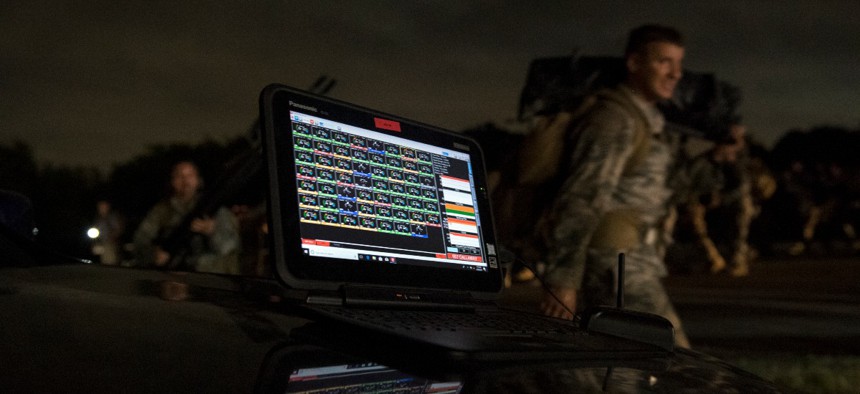
A compute displays up to 300 data points monitoring the strengths and weaknesses of Air Force Special Operations recruiters during an after-midnight ruck march at the 350th Battlefield Airman Training Squadron at Joint Base San Antonio-Lackland in San Antonio, Texas June 28, 2018. EJ Hersom/DOD
Oversight of Special Operations Forces Requires Better Data, Watchdog Says
The data collected by U.S. Special Operations Command lacks consistency and transparency, the Government Accountability Office found.
The Department of Defense needs to centralize its data collection mechanisms and standardize terminology across its command-and-control structures to improve oversight of its special operations forces, according to a report released by the Government Accountability Office on Wednesday.
Congress requested that GAO review the structure and organization of the U.S. Special Operations Command—or USSOCOM—in a House report that accompanied the fiscal year 2021 National Defense Authorization Act. USSOCOM, which is tasked with overseeing the special operations of all U.S. military branches, had 28 different command and control structures managing special operations forces across the globe in 2021.
GAO said in its report that oversight of USSOCOM’s different command and control structures was hindered by a lack of consistency and transparency surrounding collected data, since “it does not use standard terminology for this data, the data is not readily available and it does not maintain complete data.”
"As such, there is not a consistent way to determine the composition of [special operations forces command and control] structures across the enterprise and maintain accountability of personnel assigned to [special operations forces command and control] structures," GAO added.
The lack of centralized data collection mechanisms, in particular, “obscure the understanding of how [command and control] structures are deployed in theater and thus the investments needed to bolster and support the force,” according to the report. GAO noted that USSOCOM collects information about its different command and control structures “through ad hoc data collection requests” and often relies on other military commands “to collect and to present information to them.”
GAO’s report also found that data on the staffing of command and control structures was incomplete from 2018 through 2021, which hindered oversight of deployed special operations forces. In one cited example, the Naval Special Warfare Command was unaware that it had personnel deployed to the Joint Task Force Indo-Pacific team “until USSOCOM officials learned of the deployment when reviewing personnel reports, due to informal staffing assignments by [special operations forces] commanders.”
GAO said using “a standard terminology and establishing a centralized data collection mechanism” would allow DOD to improve the transparency of the command and control structures of its special operations forces, which “would further enhance oversight conducted by DOD and other entities, such as the Congress.”
The report recommended that DOD work to ensure that military officials overseeing special operations forces “establish a centralized data collection mechanism or process to collect and to retain data on a regular basis” about command and control structures. It also recommended that the same officials develop a standard terminology to address command and control structures ”whether through updated doctrine, guidance or other means.” DOD concurred with both recommendations.




